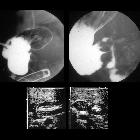akzessorisches Brustdrüsengewebe


















Accessory breast tissue is a relatively common congenital condition in which abnormal accessory breast tissue is seen in addition to the presence of normal breast tissue. This normal variant can present as a mass anywhere along the course of the embryologic mammary streak (axilla to the inguinal region).
Common locations
- chest wall
- vulva
- axilla
- knee
- lateral thigh
- buttock
- face
- ear
- neck
Epidemiology
Found in 2-6% of women and 1-3% of males . Although present from birth, patients are often not aware of it until puberty.
Clinical presentation
Most women are unaware of their accessory breast tissue and it is detected incidentally on a mammogram. Discomfort, pain, milk secretion, axillary thickening, and local skin irritation can occur. Accessory breast tissue responds to hormonal stimulation and may become more evident during menarche, pregnancy, or lactation. On examination, supranumerary nipples may also be seen.
Pathology
This tissue ranges from a small focus of parenchyma to complete structures (which may include nipple and areola).
It is also important to remember that both benign and malignant diseases of breast tissue in ectopic locations in adult women have been described.
Location
Accessory breast tissue can be found anywhere along the thoracoabdominal region of the milk line (the embryologic mammary streak) but are most frequently found in the axilla and may occur bilaterally. They are very rarely seen in the face, back, and thigh.
Associations
Various disorders associated with supernumerary nipples include:
- urogenital defects
- vertebral abnormalities
- hypertrophic pyloric stenosis
- testicular cancer
- aberrant ventricular conduction
Radiographic features
Most accessory breast tissue is found coincidentally on routine screening mammography.
Breast ultrasound
Ultrasound imaging shows breast tissue, indistinguishable from regular breast.
Breast MRI
Occasionally performed in challenging atypical cases but in practice this is rarely needed. The signal and enhancement characteristics are similar to normal glandular tissue.
Treatment and prognosis
No treatment is required in the vast majority of cases. The treatment of choice for symptomatic accessory axillary breast tissue is surgical excision as removal of the tissue will relieve physical discomfort or mechanical discomfort in the case of large volume accessory tissue.
In common with regular breast tissue, accessory mammary tissue may exhibit malignancy, fibroadenoma, mastitis, and fibrocystic change. The ectopic breast tissue has been found to have a higher propensity to develop malignancy and occurs at an earlier age. Excessive breast growth (macromastia) can be seen in pregnancy as well as during adolescence.
Siehe auch:
- hypertrophe Pylorusstenose
- Polythelie
- maligne Neoplasien des Hodens
- Milchleiste
- Mammakarzinom in ektopem Drüsengewebe
und weiter:

 Assoziationen und Differentialdiagnosen zu Mamma accessoria:
Assoziationen und Differentialdiagnosen zu Mamma accessoria:

